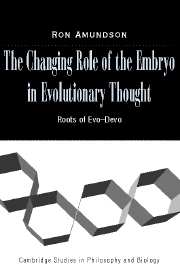Book contents
- Frontmatter
- Contents
- Acknowledgments
- 1 Introduction
- PART I DARWIN'S CENTURY: BEYOND THE ESSENTIALISM STORY
- 2 Systematics and the Birth of the Natural System
- 3 The Origins of Morphology, the Science of Form
- 4 Owen and Darwin, The Archetype and the Ancestor
- 5 Evolutionary Morphology: The First Generation of Evolutionists
- 6 Interlude
- PART II NEO-DARWIN'S CENTURY: EXPLAINING THE ABSENCE AND THE REAPPEARANCE OF DEVELOPMENT IN EVOLUTIONARY THOUGHT
- References
- Index
3 - The Origins of Morphology, the Science of Form
Published online by Cambridge University Press: 05 June 2012
- Frontmatter
- Contents
- Acknowledgments
- 1 Introduction
- PART I DARWIN'S CENTURY: BEYOND THE ESSENTIALISM STORY
- 2 Systematics and the Birth of the Natural System
- 3 The Origins of Morphology, the Science of Form
- 4 Owen and Darwin, The Archetype and the Ancestor
- 5 Evolutionary Morphology: The First Generation of Evolutionists
- 6 Interlude
- PART II NEO-DARWIN'S CENTURY: EXPLAINING THE ABSENCE AND THE REAPPEARANCE OF DEVELOPMENT IN EVOLUTIONARY THOUGHT
- References
- Index
Summary
MORPHOLOGY AND NATURAL THEOLOGY
Morphology is the study of organic form. It began as a branch of systematics, but it grew into one of the central biological disciplines of the nineteenth century (Nyhart 1995). In response to Darwin's Origin, morphology became one of the two distinct and enduring approaches to the study of evolution, the other being neo-Darwinism itself. The basic research program of morphology will follow our discussion throughout the book, even to the modern day.
In this chapter I have two goals. First, I sketch the origins and early nature of the research program of morphology. Second, I discuss and evaluate how practitioners of SH have dealt with pre-Darwinian morphology. One particular interpretation has been extremely influential. Peter Bowler in 1977 argued that pre-Darwinian British morphology should be seen as an innovative version of natural theology, in particular an “idealistic version of the Argument from Design” (Bowler 1977). This interpretation immediately caught on, and it has been accepted not only by authors with an SH orientation (Ruse 1979, Mayr 1982) but also by those with a structuralist slant (Ospovat 1981; Gould 2002). Nevertheless, I believe the interpretation to be importantly misleading. My (revisionist) understanding of the history of evolutionary theory requires that we recognize a deep division between the pre-Darwinian natural theologians and the morphologists. If we see morphologists as natural theologians, we will be unable to recognize the importance of their contributions to evolutionary theory.
- Type
- Chapter
- Information
- The Changing Role of the Embryo in Evolutionary ThoughtRoots of Evo-Devo, pp. 53 - 75Publisher: Cambridge University PressPrint publication year: 2005



